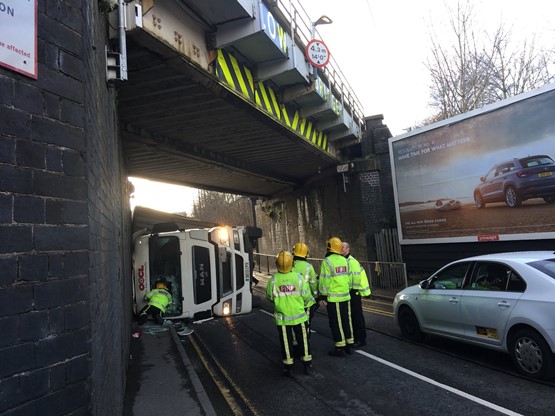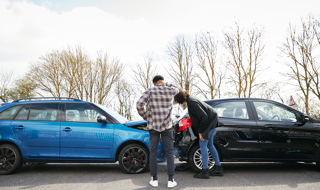Bridge strikes are a “serious problem for the industry”, according to senior traffic commissioner Richard Turfitt.
Network Rail says that, on average, five entirely avoidable railway bridge strikes take place every day across Britain, costing taxpayers £23 million a year.
Research shows more than two-in-five (43%) of lorry drivers admit to not measuring their vehicle before heading out on the road, while more than half (52%) report not taking low bridges into account.
Turfitt said there was growing frustration among commuters, suffering delays as a result of bridge strikes, and hinted that it could lead to tougher action against companies for failing to route their vehicles correctly.
“We can joke about the stupidity of drivers but this is becoming a very serious problem for the industry,” Turfitt said.
“It’s creating huge problems for the public, with passengers sitting on trains for hours.”
Addressing delegates at the recent Woodfines road transport conference, he continued: “You need to make sure route planning is done properly. Control the route, your operation and instruct your drivers properly. Otherwise, I will take action.”
Turfitt’s warning comes as Network Rail said drivers should always know the height of their vehicle, after repeated bridge strikes forced a road in Birmingham to close for five months.
The bridge, which carries the railway over Landor Street in the Bordesley Green area of the city, has been hit 32 times since 2009.
That was when a special collision protection beam was fitted to reinforce the bridge but now it has to be replaced.
After 10 years of continual bridge bashes the beam was damaged beyond repair on January 9 prompting an emergency road closure.
Engineers are now having to design and make a new steel protection beam before refitting it.
Piers Burford, project manager for Network Rail, said: “Bridge strikes are entirely avoidable, cost taxpayers millions of pounds and cause delays to tens of thousands of rail passengers every year.
“The closure of Landor Street has also caused motorists and businesses in the area considerable disruption throughout 2019.”
Cllr Waseem Zaffar, cabinet member for transport and environment at Birmingham City Council, added: “I would urge drivers of HGVs to ensure they are fully aware of the height of their vehicles in order to avoid striking bridges.
“In the case of Landor Street, this has happened repeatedly and has caused significant disruption to small business owners due to the resulting road closure impacting on trade.”
To combat the issue, Network Rail has launched its ‘Lorries Can’t Limbo’ campaign aimed at professional drivers who drive high-sided vehicles.
It includes online training and guidance in several languages to help drivers and logistics companies plan their routes to avoid bridge strikes.
Some bridges were struck repeatedly last year, with the greatest number of strikes being 32, reported at a bridge over the A142 in Ely, Cambridgeshire.
The next highest during the 12-month period was 23, involving a bridge over the B109 in Stonea, Cambridgeshire, followed by a bridge on the A5 in Hinkley, Leicestershire, which was hit 22 times.
Typically, there are five strikes a day, increasing to 10 a day at peak times such as the run up to Christmas.
 Train delays resulting from bridge collisions can be significant. For instance, in the first three months of 2019, there were 20 bridge strikes across the Anglia route, leading to 851 minutes of delayed trains.
Train delays resulting from bridge collisions can be significant. For instance, in the first three months of 2019, there were 20 bridge strikes across the Anglia route, leading to 851 minutes of delayed trains.
When a bridge strike is reported to Network Rail, it contacts a signaller, who stops the trains before an examination of the bridge can be undertaken.
Train services will resume as soon as Network Rail considers the bridge safe.
This typically takes less than an hour from first call to control... but it can take longer, it said.
The time taken to restore passenger services depends on the extent of the damage, time of day and bridge location.
 Good practice guides have been developed in conjunction with freight and passenger transport industry partners, says Network Rail.
Good practice guides have been developed in conjunction with freight and passenger transport industry partners, says Network Rail.
These are designed to raise the awareness of professional drivers and managers of freight and passenger transport companies to the risks and consequences of bridge strikes, and to give guidance to them on how they can be prevented.
 There are four Department for Transport guides on avoiding low bridges aimed at transport managers, professional drivers and operational staff.
There are four Department for Transport guides on avoiding low bridges aimed at transport managers, professional drivers and operational staff.
LEVEL CROSSING WARNING FOR COMMERCIAL FLEETS
Commercial fleet drivers and operators have also been warned not to ignore red lights at level crossings.
Almost a quarter (23%) of professional drivers admitted that, if they knew the train timetable and did not believe a train was due to arrive, they would drive over a level crossing, according to the survey from Network Rail.
The most common reasons cited for taking the risk was running late to make a delivery (12%) or a desire to finish work and get home early (16%).
Britain has the safest railway in Europe, but last year saw a 7% rise in the number of incidents at level crossings, causing more than 93,000 minutes of rail journey delays.
Although professional drivers were responsible for roughly 10% of those incidents, they had greater impact resulting in more than 43,000 minutes of delay, almost half (46%) of the total for the year.
Head of passenger and public safety at Network Rail Allan Spence said: “We know that professional drivers have time pressures, but it is important to act safely at level crossings to keep both themselves and others from harm.
“It’s simple: every driver must wait for the flashing lights to stop before crossing. It only takes one mistake – such as presuming trains will run to the timetable – to cause an incident that can harm both you and people on the trains.”




















Login to comment
Comments
No comments have been made yet.